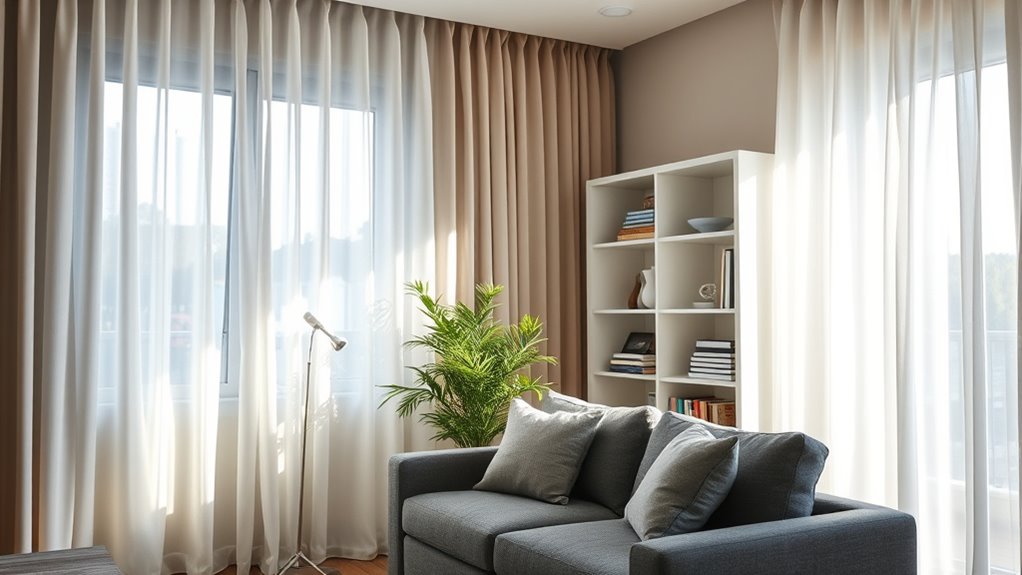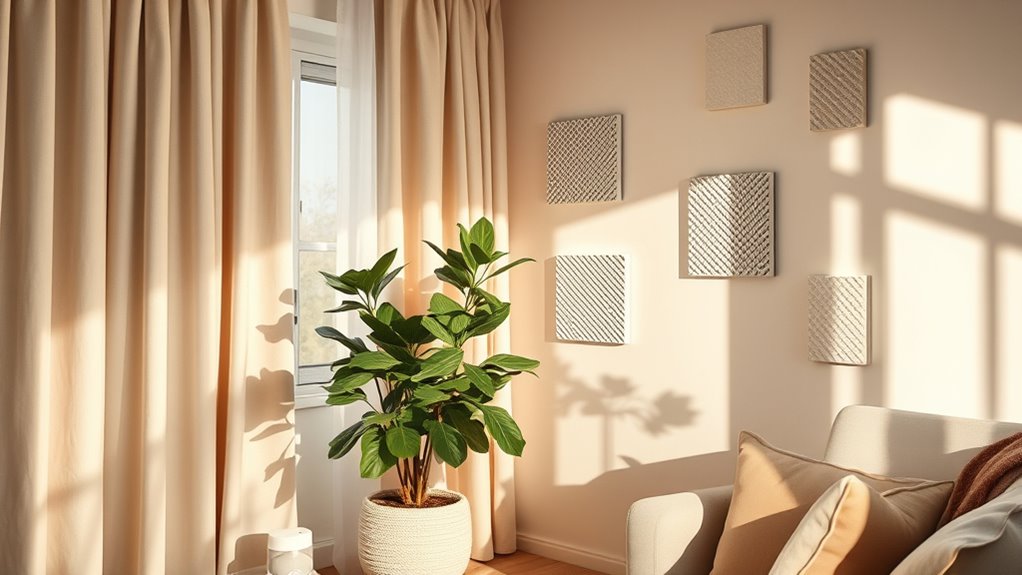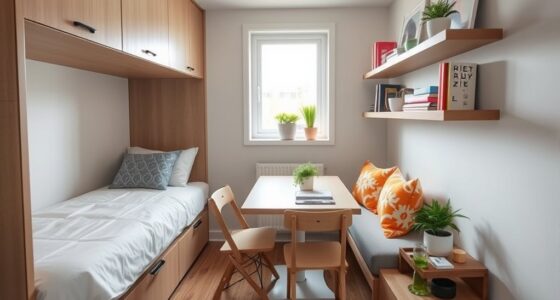To create quiet zones at home, start by adding soundproof curtains made from dense fabrics to block outside noise. Use white noise machines or fans to mask disruptive sounds and improve sleep or relaxation. Incorporate soft materials like rugs and upholstered furniture to absorb echoes and reduce noise reflection. Seal gaps around windows and doors to prevent sound leaks, and position furniture away from external walls. Combine these steps, and you’ll make your home a peaceful retreat—more tips await if you explore further.
Key Takeaways
- Use soundproof curtains to block external noise and create quiet zones inside your home.
- Incorporate white noise machines to mask disruptive sounds and enhance acoustic comfort.
- Add soft materials like rugs, upholstered furniture, and wall hangings to absorb sound and reduce echoes.
- Seal gaps around doors and windows with weatherstripping or draft stoppers for better noise insulation.
- Position beds and workspaces away from external walls and sources of noise for a more peaceful environment.

Have you ever noticed how noise from neighbors, appliances, or traffic can disrupt your peace at home? It’s frustrating when outside sounds seep in and make it hard to relax, work, or sleep. The good news is, you can create quiet zones within your space to restore your calm. One effective way is to invest in soundproof curtains. These curtains are designed with dense, specialized fabrics that absorb sound waves, reducing the noise that enters your room. When you draw them shut, they form a barrier against intrusive sounds, helping you enjoy a quieter environment. Pairing soundproof curtains with other noise-reducing strategies can make a noticeable difference, especially when combined with white noise machines.
White noise is another powerful tool in your quiet zone arsenal. It works by masking disruptive sounds with a consistent, soothing background hum. Think of it as a sonic blanket that covers up the clatter of traffic or the chatter from neighboring units. You can use a white noise machine, an app, or even a fan to generate this calming sound. Many people find that white noise not only reduces the impact of external noise but also improves sleep quality by creating a stable acoustic environment. It’s especially helpful if you live in a busy area or have loud appliances that can’t be entirely silenced.
Creating a dedicated quiet zone involves more than just adding soundproof curtains and white noise. You should also consider the placement of furniture and other soft materials that absorb sound. Rugs, upholstered furniture, and wall hangings can help dampen echoes and reduce overall noise levels. If possible, position your bed or workspace away from external walls or windows where noise is most prominent. Sealing gaps around doors and windows with weatherstripping or draft stoppers can prevent outside sounds from sneaking in. Additionally, soundproofing techniques such as adding mass to walls or installing acoustic panels can significantly enhance your noise reduction efforts. Combining these physical modifications with soundproof curtains and white noise creates a layered defense against noise pollution.
Frequently Asked Questions
How Can I Measure Noise Levels Accurately at Home?
To measure noise levels accurately at home, you can use decibel meters or sound level apps on your smartphone. Decibel meters are specialized devices that give precise readings, while sound level apps are convenient and easy to use. Simply calibrate your device if needed, then hold it at ear level in different areas to identify noisy spots. Regular measurements help you create effective quiet zones and reduce overall noise pollution.
What Are the Legal Noise Limits for Residential Areas?
Imagine a quiet street, where gentle whispers replace loud noises. You need to know that noise ordinances and decibel regulations set legal limits in residential areas, typically around 55-65 decibels during daytime and lower at night. These rules help maintain peace, so check your local laws to guarantee you’re within legal noise limits. Staying compliant means you can enjoy your home without disturbing neighbors or risking penalties.
Are There Eco-Friendly Soundproofing Options Available?
You can find eco-friendly soundproofing options by choosing sustainable solutions like recycled denim insulation, cork panels, or sheep wool. These eco-friendly materials absorb sound naturally and reduce environmental impact. Using sustainable solutions not only creates quiet zones but also supports eco-conscious living. You’ll enjoy a peaceful space while minimizing your carbon footprint. Incorporate these materials into your walls, ceilings, or floors for an effective, environmentally friendly way to block noise.
How Do Noise Levels Affect Mental Health Over Time?
Noise levels impact your mental health by causing noise-induced stress, which can build up over time. Long-term exposure to loud environments may lead to anxiety, depression, and difficulty concentrating. You might also experience sleep disturbances, affecting your overall well-being. To protect your mental health, create quiet zones at home, reduce background noise, and practice relaxation techniques. Managing noise exposure helps minimize these long-term health effects and promotes a calmer, healthier mind.
Can Plants Help Reduce Noise Pollution Indoors?
You might wonder if plants can help reduce indoor noise pollution. Placing indoor plants strategically around your space can improve sound absorption through their foliage, effectively reducing noise levels. Focus on high foliage noise absorption areas like corners or near noisy appliances. By choosing the right indoor plant placement, you create a quieter environment, making your home more peaceful and comfortable without extensive soundproofing efforts.
Conclusion
Creating quiet zones at home can markedly reduce your exposure to noise pollution, which affects over 70% of urban residents worldwide. By implementing simple measures like soundproofing or using noise-canceling devices, you can enjoy a peaceful environment. Remember, a quieter home isn’t just more relaxing—it’s better for your health and well-being. Start today, and reclaim your space from unwanted noise—your peace of mind is worth it.









